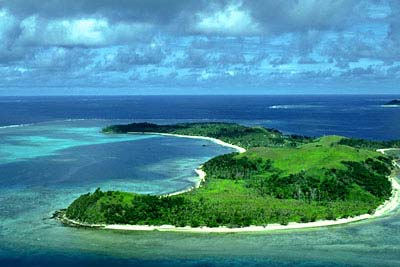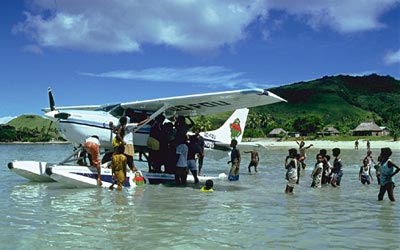
Floats & Frangipani!
Life of a Bush Pilot in the Fiji Islands

Most Canadians still
stereotype a bush pilot as a rugged, grizzled individual in a plaid shirt
and faded work pants, flying Indian trappers in a shabby but reliable old
Beaver, or hauling fish in a venerable Noorduyn Norseman off Canada's
northern lakes. Similarly, they might picture a weathered northern denizen
in a down-filled parka, his face hidden by a fur-trimmed hood, using a
Herman Nelson heater on a bitterly cold winter morning to warm a
ski-equipped single Otter, or a stripped out DC-3.
![]() Not many
people, however, would imagine a bush pilot in short-sleeved shirt,
shorts, and well-tanned bare feet, flying floatplanes - in the middle of
winter - off coconut palm-lined beaches in the tropical South Pacific.
Not many
people, however, would imagine a bush pilot in short-sleeved shirt,
shorts, and well-tanned bare feet, flying floatplanes - in the middle of
winter - off coconut palm-lined beaches in the tropical South Pacific.
![]() Finding
Canadian multi-IFR pilots in different parts of the world is not unusual.
Twin Otter jobs can be found in North Africa, Asia, or South America, but
VFR floatpilots get few international job choices. So when I was offered a
job in January of 1983, flying a Cessna 206 floatplane for Turtle Airways
in Fiji, I packed my toothbrush and sunglasses, and caught the next CP Air
flight south.
Finding
Canadian multi-IFR pilots in different parts of the world is not unusual.
Twin Otter jobs can be found in North Africa, Asia, or South America, but
VFR floatpilots get few international job choices. So when I was offered a
job in January of 1983, flying a Cessna 206 floatplane for Turtle Airways
in Fiji, I packed my toothbrush and sunglasses, and caught the next CP Air
flight south.
![]() I first
glimpsed the Fiji archipelago in April of 1971, from an American Airlines
Boeing 707 flight to Australia. The captain called our attention, about
six hours out of Honolulu, to a group of over 330 dormant volcanic islands
far below. Wandering coral reefs, second in total area only to Australia's
Great Barrier Reef, surround practically all of Fiji's islands, forming
many protected lagoons and bays. Mountainous Viti Levu (Mount Victoria the
highest peak at 1302m), with deep ravines worn into the hillsides by a
millennium of tropical rains, is the group's largest island. The
prevailing southeast trade winds dump their abundant moisture on Viti
Levu's upwind slopes to sustain lush rain forests and leaving the lee wind
side, where the Nadi International Airport is located, to enjoy dryer,
more predictable weather almost all year.
I first
glimpsed the Fiji archipelago in April of 1971, from an American Airlines
Boeing 707 flight to Australia. The captain called our attention, about
six hours out of Honolulu, to a group of over 330 dormant volcanic islands
far below. Wandering coral reefs, second in total area only to Australia's
Great Barrier Reef, surround practically all of Fiji's islands, forming
many protected lagoons and bays. Mountainous Viti Levu (Mount Victoria the
highest peak at 1302m), with deep ravines worn into the hillsides by a
millennium of tropical rains, is the group's largest island. The
prevailing southeast trade winds dump their abundant moisture on Viti
Levu's upwind slopes to sustain lush rain forests and leaving the lee wind
side, where the Nadi International Airport is located, to enjoy dryer,
more predictable weather almost all year.
![]() On that
flight over Fiji, I also remember the flight attendants passing around
certificates testifying that we had just flown across the International
Date Line. In fact, the majority of Fiji's islands lie just west of 180
longitude. So I journeyed into "tomorrow" with Fiji impressed in
my memory.
On that
flight over Fiji, I also remember the flight attendants passing around
certificates testifying that we had just flown across the International
Date Line. In fact, the majority of Fiji's islands lie just west of 180
longitude. So I journeyed into "tomorrow" with Fiji impressed in
my memory.
Click on the images to get
a larger view
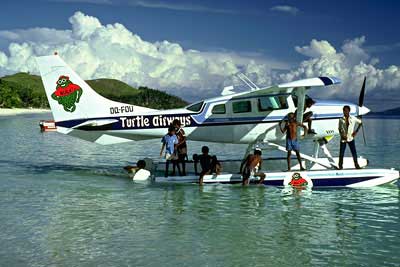
Now that I am flying for Turtle
Airways many of my Australian passengers exclaim, "Fair dinkum, mate,
do you really get paid for doing this? How did you manage to get such a
fabulous job?"
![]() "By
being in the right place at the right time," I always say. When my
wife and I were on holidays in Fiji in November of 1981, I met the Turtle
Airways' Chief Pilot. Ian Burgin. We got together one evening and swapped flying
stories over a fruit punch at Nadi's Gateway Hotel. Remembering our
conversation, the Chief Pilot 'phoned one cold winter night 16 months
later, to offer me a newly-opened position. The only convincing I needed
was to look out my window.
"By
being in the right place at the right time," I always say. When my
wife and I were on holidays in Fiji in November of 1981, I met the Turtle
Airways' Chief Pilot. Ian Burgin. We got together one evening and swapped flying
stories over a fruit punch at Nadi's Gateway Hotel. Remembering our
conversation, the Chief Pilot 'phoned one cold winter night 16 months
later, to offer me a newly-opened position. The only convincing I needed
was to look out my window.
![]() Turtle
Airways' domain includes the most picturesque sun-washed tropical islands
imaginable: graceful palm trees, soft white coral beaches, and
exceptionally clear aquamarine waters. Lying off Viti Levu's west coast,
the Mamanuca Islands swing outward from Nadi towards the sunset, the
resulting curve half encircling Nadi Bay. The Yasawa Islands continue from
there northeasterly in an asymmetrical 80km line. Together, the islands
dot the waters like corks in a fisherman's net, trapping inside numerous
coral islands and scatterings of coral reefs and cays, with the net's
mouth finally spilling open and taking in the northern Bligh Waters.
Turtle
Airways' domain includes the most picturesque sun-washed tropical islands
imaginable: graceful palm trees, soft white coral beaches, and
exceptionally clear aquamarine waters. Lying off Viti Levu's west coast,
the Mamanuca Islands swing outward from Nadi towards the sunset, the
resulting curve half encircling Nadi Bay. The Yasawa Islands continue from
there northeasterly in an asymmetrical 80km line. Together, the islands
dot the waters like corks in a fisherman's net, trapping inside numerous
coral islands and scatterings of coral reefs and cays, with the net's
mouth finally spilling open and taking in the northern Bligh Waters.
Captain Bligh and his faithful
crew sailed through these waters after being set adrift by the Bounty's
infamous mutineers. He did not stop, however, because he was chased from
the islands by the then-fierce and cannibalistic Fijian warriors. Today
the big dark Fijian people are friendly, genuine, and open. They smile and
wave at every opportunity, meeting everyone with the native greeting,
"Bula."
![]() A small,
but busy, airline flying tourists to and from the various island resorts,
Turtle Airways maintains three Cessna 206s on C3500 PK floats, and two or
three pilots, depending on the workload. The Stationairs are kept in
excellent shape considering the high salt density in the 27C-plus tropical
waters. They keep corrosion to a minimum by dollying the planes out of the
"salt chuck" every night and washing them inside and out with
fresh water. Because of the inexpensive labor on Fiji, they can also
afford to completely de-corrode and paint the aircraft at least once a
year: a distinctive two-tone blue, with a bright read and green "Tui
the Turtle" painted boldly on the tail and floats.
A small,
but busy, airline flying tourists to and from the various island resorts,
Turtle Airways maintains three Cessna 206s on C3500 PK floats, and two or
three pilots, depending on the workload. The Stationairs are kept in
excellent shape considering the high salt density in the 27C-plus tropical
waters. They keep corrosion to a minimum by dollying the planes out of the
"salt chuck" every night and washing them inside and out with
fresh water. Because of the inexpensive labor on Fiji, they can also
afford to completely de-corrode and paint the aircraft at least once a
year: a distinctive two-tone blue, with a bright read and green "Tui
the Turtle" painted boldly on the tail and floats.
![]() Nevertheless, after working here for nearly a year, I must admit that
paradise does not have utopia-like flying conditions at all times. Somehow, despite the exotic surroundings, the problems all sound vaguely
familiar. Ocean swells big enough to surf on are as hard as a brick wall
if you don't handle them right. Fully loaded glassy water take-offs on a
muggy 35C afternoon, with only two kilometers of lagoon before reaching
the unyielding shark-tooth reefs, are enough work to make even the coolest
professional perspire. In addition, there are isolated coral heads
scattered everywhere that can be disastrous if you misjudge or forget
their position.
Nevertheless, after working here for nearly a year, I must admit that
paradise does not have utopia-like flying conditions at all times. Somehow, despite the exotic surroundings, the problems all sound vaguely
familiar. Ocean swells big enough to surf on are as hard as a brick wall
if you don't handle them right. Fully loaded glassy water take-offs on a
muggy 35C afternoon, with only two kilometers of lagoon before reaching
the unyielding shark-tooth reefs, are enough work to make even the coolest
professional perspire. In addition, there are isolated coral heads
scattered everywhere that can be disastrous if you misjudge or forget
their position.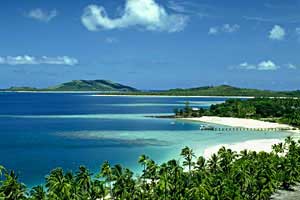
![]() Therefore,
the sturdy PK floats are essential to the company's (and the pilot's)
well-being because, as experience has proven, normally constructed floats
are annihilated in a period of months. The extra thick aluminum, heavy
metal skegs, and deep V design are ideal for cutting through
kidney-jarring rough water and ocean swells, and bumping across the
occasional misplaced coral reef. The only change, I believe, that would
improve the PK floats would be installing a good old Canadian Beaver on
them.
Therefore,
the sturdy PK floats are essential to the company's (and the pilot's)
well-being because, as experience has proven, normally constructed floats
are annihilated in a period of months. The extra thick aluminum, heavy
metal skegs, and deep V design are ideal for cutting through
kidney-jarring rough water and ocean swells, and bumping across the
occasional misplaced coral reef. The only change, I believe, that would
improve the PK floats would be installing a good old Canadian Beaver on
them.
![]() Despite
all that, things still do break. Ravi, who once worked as an engineer for
Turtle Airways, recalled: "We used to change broken flying wires at
least once a week. One time, a float strut broke on a rough water
take-off; the pilot continued on and flew his passengers over to Mana
Island where he knew he could land safely in the calm lagoon. The right
front strut was bent 90 degrees in the middle, and the airplane knelt
forward like a horse with a broken leg. There was no way he could fly the
plane back like that. There was a danger the other strut might collapse,
and we had no way to change the strut in Mana. But luckily, Dave was a
Canadian bush pilot and they know how to fix those things. He placed
several two-by-fours under the broken strut, cinched the whole thing
together with rope, and flew it back home. The splint was so sturdy, he
could have flown all day the way it was."
Despite
all that, things still do break. Ravi, who once worked as an engineer for
Turtle Airways, recalled: "We used to change broken flying wires at
least once a week. One time, a float strut broke on a rough water
take-off; the pilot continued on and flew his passengers over to Mana
Island where he knew he could land safely in the calm lagoon. The right
front strut was bent 90 degrees in the middle, and the airplane knelt
forward like a horse with a broken leg. There was no way he could fly the
plane back like that. There was a danger the other strut might collapse,
and we had no way to change the strut in Mana. But luckily, Dave was a
Canadian bush pilot and they know how to fix those things. He placed
several two-by-fours under the broken strut, cinched the whole thing
together with rope, and flew it back home. The splint was so sturdy, he
could have flown all day the way it was."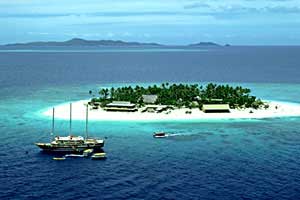
![]() Then, even
in paradise, there are those inevitable days when you spend all afternoon
dodging black monsoon downpours like a running-back dodging tackles; or
you suddenly develop hydrophobia as a flight takes you across 100 nautical
miles of frothing, seething, open ocean blown wild by 35 knot winds. At
the half-way point, a nervous passenger taps you on the shoulder and asks,
"Is that a shark I see down there, mate?" "Are you sure we
have enough petro'? That gauge reads empty." Those are the days when
you love the guys on Continental's engine assembly line, but hate whoever
makes those damn fuel gauges, and when you hate your dispatcher for
sending you on such a haywire flight, but because you love flying you
would rather be here than anywhere else.
Then, even
in paradise, there are those inevitable days when you spend all afternoon
dodging black monsoon downpours like a running-back dodging tackles; or
you suddenly develop hydrophobia as a flight takes you across 100 nautical
miles of frothing, seething, open ocean blown wild by 35 knot winds. At
the half-way point, a nervous passenger taps you on the shoulder and asks,
"Is that a shark I see down there, mate?" "Are you sure we
have enough petro'? That gauge reads empty." Those are the days when
you love the guys on Continental's engine assembly line, but hate whoever
makes those damn fuel gauges, and when you hate your dispatcher for
sending you on such a haywire flight, but because you love flying you
would rather be here than anywhere else.
![]() Most of
the time, however, the pace in Fiji, as well as the flying, is typically
South Pacific: slow, even tempered, and down-right drowsy. When you land
at reef-encircled Beachcomber or Treasure Island, for instance, the Fijian
who boats your passengers to shore might promptly scramble out to meet the
plane; but then again, he might be napping.
Most of
the time, however, the pace in Fiji, as well as the flying, is typically
South Pacific: slow, even tempered, and down-right drowsy. When you land
at reef-encircled Beachcomber or Treasure Island, for instance, the Fijian
who boats your passengers to shore might promptly scramble out to meet the
plane; but then again, he might be napping.
![]() To solve
that problem, I asked our dispatcher, Olaf, to 'phone ahead so that the
boat could be prepared to meet the plane. "Yes," Treasure
Island's receptionist said, "not to worry." But when I landed
again, there was no boat. Half an hour later, the boat finally showed up.
To solve
that problem, I asked our dispatcher, Olaf, to 'phone ahead so that the
boat could be prepared to meet the plane. "Yes," Treasure
Island's receptionist said, "not to worry." But when I landed
again, there was no boat. Half an hour later, the boat finally showed up.
![]() "Right on time," I said sarcastically.
"Right on time," I said sarcastically.
![]() With a
toothy grin, the Fijian boat boy laughed, "lo, Fiji time."
With a
toothy grin, the Fijian boat boy laughed, "lo, Fiji time."
![]() When I
returned to base, our dispatcher smiled and slowly shook his head.
"That doesn't give them more time to prepare, it only gives them more
time to forget."
When I
returned to base, our dispatcher smiled and slowly shook his head.
"That doesn't give them more time to prepare, it only gives them more
time to forget."
Article and Images by John S Goulet
![]()
The attitude indicator will guide you to Part Two.
 Top of this story.
Top of this story.
![]() Last modified on
October 29, 2006 .
Last modified on
October 29, 2006 .
© Virtual
Horizons, 1996.
